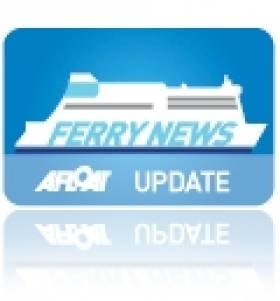Displaying items by tag: MV Arrow
The Isle of Man Steam Packets' chartered in MV Arrow, which is used by the Manx ferry operator to cover freight traffic, ran aground in Aberdeen Harbour, Scotland (yesterday).
The (ro-ro freightferry),reports Manx Radio, is on a sub-charter to Serco-Northlink for Aberdeen-Northern Isles services (see related Afloat story).
According to the BBC News, the Arrow 'got into difficulties during manoeuvres on its arrival from Lerwick (Shetland) early this morning, and ran aground at the entrance to the harbour.
She was freed by harbour tugs, with no injuries reported, whilst a full investigation with the relevant parties will be conducted.
The vessel is on a long-term charter to the Steam Packet, but has been sub-charted to Serco-Northlink for two weeks.
It's being managed and crewed by Seatruck Ferries during this period.
Extra Freight Ferry Chartered for Manx TT Races
#MANX TT RACES FERRY NEWS – According to BBC News, an additional ro-ro freight-ferry has been chartered from Seatruck Ferries by the Isle of Man Steam Packet Company in order to cope with demand during the TT races.
More than 11,200 motorbikes are already booked to arrive in Douglas during race fortnight, which begins on Monday. The number is the highest for a decade with the exception of the event's centenary in 2007.
The chartered vessel is the Arrow (1998/7,606grt), which will assist in peak periods. The 122m long vessel can transport around 1,000 metres of freight and is the sister ship of Helliar, which covered during the island's passenger ferry Ben-my-Chree's scheduled dry dock.
Steam Packet Company Chief Executive Mark Woodward said: "While MV Arrow doesn't bring any additional passenger space, we have already made provision for 43,000 extra seats scheduled over the TT period."
"This second chartered vessel provides additional operational resilience during the busiest time of the year."
Seatruck to Launch New Freight Route
#NEW FREIGHT ROUTE – A new route between Belfast-Heysham is to be launched by Irsh Sea freight-only specialist Seatruck Ferries early next month, according to The Irish Trucker.
The new service will be opened on 7 May using the sisters Arrow and Ranger which will be switched from their current duties out of Larne.
Later in the year Seatruck will deploy larger vessels on the new Belfast route and move the service from Heysham to Liverpool, operating from the Seatruck terminal on the City side of the Mersey.
In Belfast, Seatruck will operate from Albert Quay terminal - directly opposite the Titanic Quarter. For much more on this story click HERE.


























































